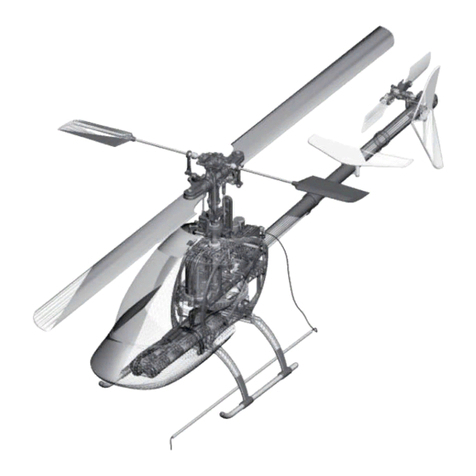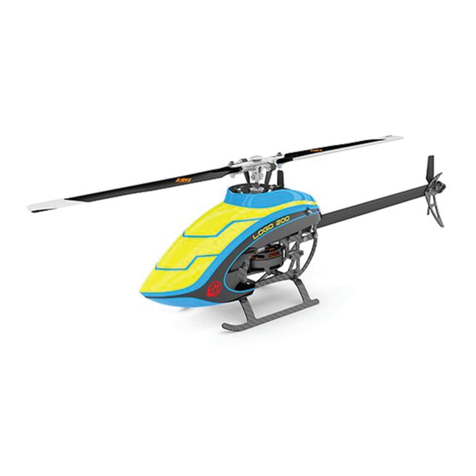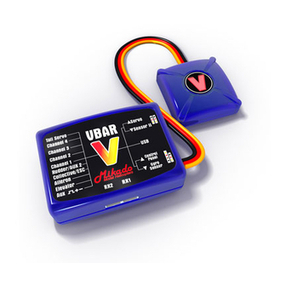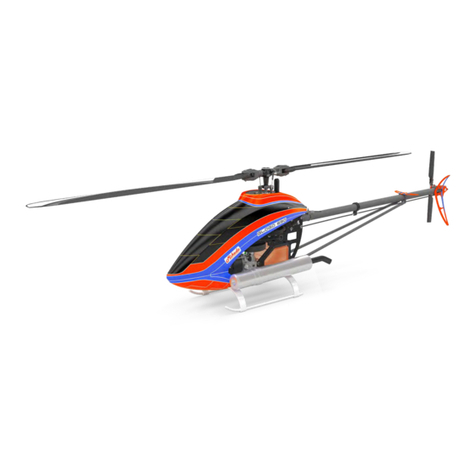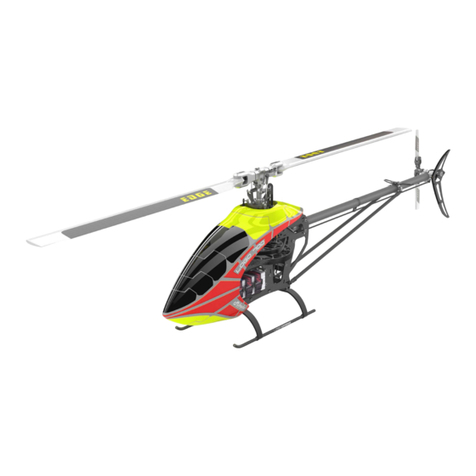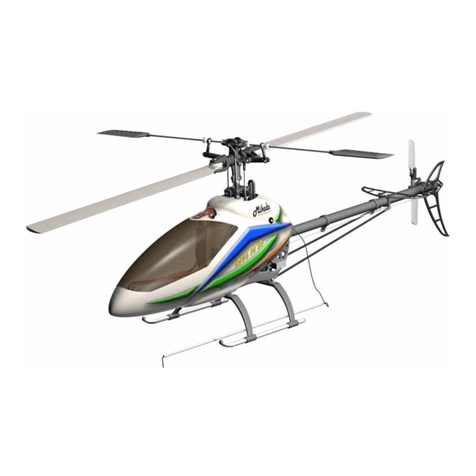
Before powering on the helicopter:
Never operate the helicopter inside closed rooms as this helicopter is intended for operation outside and may only be operated in
sites where operation of Radio Control models is permitted. . Keep the helicopter at safe distance to any persons or live animals
at all times. When trimming, keep a minimum distance of 10 yards for safety and never operate the helicopter alone. Always take
someone with you, who can help in emergency situations.
The helicopter must also not be operated in the following circumstances:
• when children are present or in places where people are gathering
• close to houses or in park areas
• inside any rooms or buildings
• places with limited space
• in adverse weather conditions, such as rain, snow, hail or during strong winds
• Near trees or High Tension wires
Techical specifi cations which must be obeyed during the operation of the
LOGO 800:
• maximum rotor head rpm: 1800 U/min.
• maximum pitch travel: +/- 12°
• Length of rotor blades: 750 to 810mm
• Lipo battery: 12-14S Lipo Batteries
• admissible temperature 5° - 35° Celsius
If these values are exceeded, the electronic components may experience overload. This may result in damage or a crash of the
helicopter.
Before the fi rst fl ight, you must check proper functioning of the motor, the ESC and the VBar. To do this, please refer to the
respective manuals. For safety reasons, these tests should be performed without mounting the main rotor blades and the tail
rotor blades. It is advisable to fl y moderately during the fi rst fl ights. This is because you need to get used to the new size of this
helicopter during the fi rst few fl ights. Do not underestimate the size and power of this helicopter. Keep a safe distance from the
ground to provide for ample reaction time.
***Tips for fl ying your Logo 800 in a safe way***
In our rigorous testing we fl ew the Logo 800 in very aggressive maneuvers and did not fi nd it to be susceptible to failure, or boom
strikes. However, due to the size of this model it is our recommendation to you that it should not be fl own in the same way which
you fl y a small helicopter or 700 size competition machine, particularly in aggressive 3D maneuvers. Please note the following
tips on how to fl y your 800 in order to ensure the long and healthy life of your model.
1. . If you will be fl ying aggressive 3D maneuvers, you MUST fi rst install the 2 x 90 shore dampers in the “Hard Damper
Confi guration” Please note more about this on page #15.
2. Do not do maneuvers which give large amounts of backwards elevator, and negative collective pitch at the same time.
Especially do not do this in a quick jab, or aggressive way. If you will give both of these commands at the same time you should
do them more smoothly. Otherwise it may result in catastrophic boom strike.
3. Utilize good pitch management when fl ying this helicopter. When fl ying you should only give large amount of collective pitch,
with low amount of cyclic, or high cyclic amount with low amount of collective pitch. But not both at the same time.
4. Do not attempt to do aggressive fl ying at low RPMs. If you want to fl y aggressive maneuvers, please use at least 1800rpm of
head speed. If you fl y with lower RPM, then you must also fl y the model in a smoother way.
5. High amounts of collective pitch with rapid right rudder inputs should be avoided. The increased torque from the collective pitch
and the right tail rotor input (against torque) will put huge amounts of stress on the tail rotor drive train.
6. If you fl y mainly with Low RPM (below 1400rpm), you can use longer tail rotor blades (120-130mm) to get a better tail authority.
But do not attempt to fl y higher 6. rpm with larger tail blades.
Index
Safety Instructions/ Tools for Assembly & RC Equipment 2
1 Chassis 3
1 Chassis and Landing Struts 5
2 Servo Mounting 7
3 Main Gear 8
4 Motor Installation 9
5 Tail Rotor 10
6 Torque Tube 11
7 Tail Boom Mounting 12
8 Tail Boom Brace 13
9 Swashplate 14
10 Rotor Head 15
11 Rotor Head Linkage 16
12 Wiring RC Components 17
13 Mounting ESC/ Battery 18
14 Canopy and Overview 19
15 Overview Spare Parts Mainframe 20
16 Overview Spare Parts Tail Boom 23
17 Overview Spare Parts Tail Rotor 24
18 Overview Spare Parts Rotor Head 25
Thank you very much for your purchase of the Mikado LOGO 800. Prior to assembly, please read and understand this manual
completely and follow all instructions exactly. If any instructions are not clear to you or if you have any questions, please contact
us. You can reach Mikado on the LOGO-Forum on www.vstabi.info or contact the Mikado support hotline via email or phone. Do
not under any circumstances fl y this helicopter if you are unsure of setup or assembly.
This helicopter is not suitable for beginners. It is expected that you have some experience in assembling and operating an RC
helicopter (model size LOGO 400 to LOGO 600, for example). You are required to adhere to the safety instructions of this manual.
You must secure all screws in all components yourself. In addition, it is necessary that you secure all other screwed connection,
by which you will assemble the diff erent components of the LOGO. We recommended to use securing glue Loctite 243 (blue).
Please follow the recommendations of the Loctite manufacture and allow proper curing time for the Loctite prior to fl ying the
model.
Safety Instructions:
RC Helicopters are not toys and must be treated with due diligence. If you do not use this helicopter responsibly it can cause
of severe injury and immense damage. Inappropriate use of this product can result in injury or death. Each user must have the
appropriate knowledge and skill to operate any RC Helicopter. Manufacturer / reseller assumes no liability for the use or operation
of this helicopter.
You are responsible for any injury and damage that may be caused by this helicopter. It is recommended that your radio
components be tested prior to installing in this helicopter. Improper radio installation or inadequate battery voltage can result
in the loss of control of the helicopter. Proper knowledge of your radio equipment is required prior to fl ying this helicopter. You
must check if other persons are using an RC-controlled model or device simultaneously, as this may result in interference. If the
helicopter behaves in an unusual or strange way, you must land it immediately and turn off the power. Please meticulously check
all of your radio gear and fi nd/fi x the problem before you continue to operate the helicopter This is to avoid any accidents. Since
one irregularity can cause other defects or problems, an increased risk of failure will ensue, if the problem is not fi xed fi rst.
Additional precautions for the prevention of injuries or damage:
Before you power on the helicopter, you must ensure that all screws and associated hardware are secured. Even just one single
loose screw can cause the helicopter to become uncontrollable resulting in a crash or personnel injury.
Also it is very important that you must check the model frequently and exchange any parts that show signs of deterioration or
wear. Failure to complete frequent pre and post fl ight inspections will result in fl ying an unsafe model and increasing the risk of
damaging the helicopter and possibly injuring yourself and/or others. Use only original Mikado parts and electronic components
which are recommended by Mikado.
Always keep a minimum of 10 yards away from a spinning rotor head. Components that run hot such as the ESC and Motor
should never be touched until ample cool down time has been provided.
Perform overspeed maneuvers only at your own risk: overspeed maneuvers may overload the components
on the helicopter and lead to damage/a crash/injury.
Hex Wrenches
1,5/2,0/2,5/3,0/4,0/6,0 mm
Grease
Ball
link
pliers
Pitch Gauge
Threadlock
Manual LOGO 800 - ©Mikado Model Helicopters GmbH - Page 2

